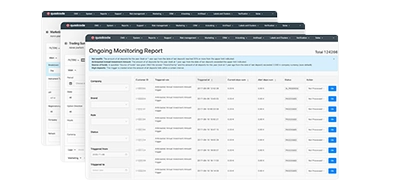Back

Brokerage Business
Who is an Introducing Broker, and How Does it Work?

Written by:
Vitaly Makarenko
read
Published:
April 3, 2024Updated:
April 25, 2024views
Table of contents
In the multifaceted world of trading, numerous entities play distinct, pivotal roles, ensuring the industry remains vibrant and functional. Among these entities, the Introducing Broker, or IB, stands out as a crucial bridge between clients and the larger brokerage world. In this article, we aim to explain the role of the IB, offering insights into its significance, operations, and value proposition in today’s financial landscape. Whether you’re a seasoned trader, a novice investor, or someone contemplating a foray into the brokerage business, understanding the dynamics of the IB will equip you with a broader perspective on how the trading world operates.
Definition and Role of an Introducing Broker
At its core, an Introducing Broker is an intermediary between retail traders and larger, full-service brokerage firms. They are primarily responsible for introducing potential clients to these larger entities.
But what does that mean in practical terms?
First and foremost, an IB is often the first point of contact for a trader or investor seeking to navigate the vast waters of the financial markets. While they might not directly execute trades or hold client funds, they play a quintessential role in guiding, advising, and directing clients to suitable full-service brokers based on their unique needs and investment goals.
Moreover, the roles of an IB transcend mere introductions. They are often involved in providing personalized services and sometimes even technical support to their clientele. Their deep-rooted relationships with larger brokers enable them to offer tailored solutions that might not be readily available to individual traders approaching brokers directly.
To better understand the ecosystem in which an Introducing Broker operates, it is crucial to differentiate between IBs, affiliates, and full-service brokers.
Introducing Brokers vs. Affiliates
While Introducing Brokers form partnerships with larger brokerage firms to direct clients their way, affiliates act as part of a broader marketing strategy for these firms. The primary distinction lies in their involvement with the client and the depth of their services. While IB often provides personalized guidance, affiliates are typically more hands-off, focusing on referring clients through online platforms or other marketing channels without offering extensive personal support or trading services.
The monetization strategies of IBs and affiliates are also notably different. IBs make money mainly through commissions or a share of the spreads from trades executed by the clients they refer. Their revenue model might be transaction-based, where they receive payment per trade, or it might involve a percentage of the spread on each trade a client makes. This model motivates IBs to maintain a close relationship with their clients and assist them in increasing their trading volume, as their earnings are directly correlated with client activity.
Affiliates, on the other hand, typically earn through a cost-per-acquisition (CPA) model or via a revenue-sharing plan. Under the CPA model, the affiliate is paid a fixed amount for each client who signs up and deposits with the broker. With revenue sharing, they receive a percentage of the revenue generated from the client’s activity over time. The affiliate model often requires less personalized interaction with the client post-referral, as the affiliate’s primary goal is to drive as many leads as possible to the broker’s website or trading platform.
Full-Service Brokers vs. Introducing Brokers
It is also crucial to understand how the Introducing Broker differs from another counterpart – the full-service brokers. Both may seem to offer similar services, but their operational methodologies and core services set them apart.
Full-service brokers typically offer various services, including executing trades, providing research and advice, portfolio management, and more. They often operate on a larger scale, directly access the financial markets, and hold client funds. Their expansive infrastructure covers everything from market research teams to technologically advanced trading platforms.
In contrast, Introducing Brokers do not execute trades or hold client funds. Instead, they serve as a liaison, bridging the gap between individual investors and these full-service entities. The strength of an IB lies in its local market knowledge, personalized client relationships, and specialized insights that cater to specific client segments. They excel in understanding their clients’ needs and directing them to the most suitable full-service broker, ensuring a symbiotic relationship that benefits all parties involved.
Benefits of Using an Introducing Broker
Given their unique position in the trading ecosystem, Introducing Brokers offers several compelling advantages to traders and investors:
- Personalized Services and Direct Contact: With a focus on building close-knit client relationships, IBs often provide a more personalized touch. They understand individual trading goals and risk appetites and can tailor advice and broker recommendations accordingly.
- Access to Specialized Knowledge and Resources: Owing to their partnerships with various full-service brokers, IBs often have a wealth of resources at their disposal. This includes specialized market reports, educational webinars, and sometimes even trading tools.
- Potential for Better Deals and Offers: Due to their volume-driven relationships with full-service brokers, IBs may negotiate better trading conditions or special offers for their clients, providing them with a competitive edge in the markets.
- Assistance with Account Management and Other Tailored Services: Beyond introductions, many IBs offer additional services like account management, trading strategy consultation, and even technical support, ensuring their clients have a seamless trading experience.
Having discussed the benefits traders gain from engaging with IBs, we must shift our focus to the other side of the equation: the full-service brokers. What advantages do they stand to reap from these partnerships?
Key Advantages for Brokers to Collaborate with IBs
The relationship between full-service brokers and Introducing Brokers is symbiotic. While traders get a more personalized touch from IBs, brokers, too, derive significant strategic and operational benefits from these partnerships. Let’s delve deeper:
Enhancing Market Reach
- Localized Expertise: IBs often possess an intricate understanding of local markets, cultures, and trading behaviors. Their localized expertise allows brokers to tailor their offerings more effectively to specific demographics.
- Tapping into Niches: Some IBs specialize in certain trading segments – be it commodities, forex, or equities. By partnering with these IBs, brokers can strategically position themselves in these niches without extensive market research.
- Global Expansion: For brokers eyeing international markets, IBs act as gateways, eliminating the challenges associated with navigating unfamiliar territories.
Streamlined Operations and Client Management:
- Delegated Preliminaries: IBs often handle preliminary processes such as client onboarding, documentation, and initial queries. This delegation frees up brokers to allocate resources to more complex tasks.
- Feedback Channel: Regular interactions with clients give IBs a wealth of feedback. This feedback loop can be invaluable for brokers, helping them refine their offerings and rectify potential pain points.
- Efficient Resource Allocation: By allowing IBs to handle specific client-facing tasks, brokers can optimize their operational costs, ensuring that their human and technological resources are used more efficiently.
Cost-effective Client Acquisition:
- Lower Marketing Expenditure: Traditional advertising and marketing campaigns are expensive. With IBs acting as client referrers, brokers can significantly reduce their marketing budgets.
- Higher Conversion Rates: Referrals from trusted IBs often have higher conversion rates than cold leads, ensuring that brokers get a better return on their investment.
- Sustainable Growth: Given the recurring nature of IB referrals, brokers can anticipate a more stable and sustainable growth trajectory devoid of the volatility of traditional marketing efforts.
For full-service brokers, collaboration with Introducing Brokers is not a mere add-on; it’s a pivotal strategy that can redefine their market presence, operational efficiency, and growth trajectory.
The Business Model of an Introducing Broker
An IB operates within a layered and multifaceted business model that, while seemingly direct, hinges on a balance of financial strategy and interpersonal acumen. Most notably, their earnings are primarily driven by the commission structures set with full-service brokers. Many IBs thrive on a revenue-sharing model, earning a share of the spread or commission charged by the main broker to the clients they’ve referred. This income often correlates with the trading volume of their introduced clients.
Some IBs might also benefit from rebates, where they earn a portion from the broker for every trade initiated by the client. In other cases, the model can be simplified with an upfront payment for each introduced client, independent of the client’s trading frequency or volume.
The relationships an IB establishes with full-service brokers or clearing firms can be varied and complex. Some offer exclusive agreements with specific brokers, trading flexibility for potentially higher commission rates or added benefits. Others, valuing adaptability, affiliate with multiple brokers. This approach broadens their horizon, enabling them to match clients to brokers based on precise needs.
However, this versatility is challenging, especially in maintaining service consistency. It’s worth noting that brokers often bolster their IBs by providing training, marketing materials, and client management tools, ensuring that clients experience uniform, high-caliber service.
Challenges
Yet, the pathway of an IB isn’t devoid of challenges. Regulatory compliance is a significant hurdle, with IBs continually adapting to ensure they operate within the defined legal frameworks. This often resource-intensive endeavor is crucial to maintain the integrity of their operations.
Further complicating their role is the necessity to foster and preserve client trust. An IB’s reputation is its most valuable asset, and a single flawed recommendation can tarnish its credibility. Moreover, as participants in the financial market, IBs aren’t insulated from market volatility. Fluctuating market conditions can sway trading volumes, subsequently influencing their earnings.
In essence, the role of an Introducing Broker, though potentially rewarding, is fraught with both opportunities and challenges. Their success is predicated on their ability to navigate the intricacies of the financial landscape while fostering robust interpersonal relationships.
Steps to Become an Introducing Broker
Becoming an Introducing Broker offers the promise of an exciting journey at the intersection of financial markets and relationship building. Yet, like all pivotal roles in the financial sector, the path to becoming an IB is meticulously charted, emphasizing due diligence and continuous learning.
Initially, aspirants must have a solid grounding in the world of finance and trading. Though not always mandated, a background in finance, business, or a related field certainly accelerates an IB’s trajectory. Familiarity with market dynamics, trading tools, and financial instruments ensures that an IB is well-positioned to offer informed advice to clients.
The regulatory landscape governing IBs varies across regions. However, a common thread is the need for registration with pertinent financial regulatory bodies. This registration is a stamp of credibility, reassuring clients and partner brokers of the IB’s legitimacy. Furthermore, in many jurisdictions, this necessitates passing qualification exams that test an individual’s knowledge of financial markets, trading ethics, and client management protocols.
Once equipped with the necessary qualifications, the next frontier for budding IBs is building relationships with clearing firms or full-service brokers. These affiliations form the backbone of an IB’s operations. The selection process should be rigorous, assessing potential broker partners based on their commission structures and reputation, trading platforms, and support mechanisms.
Lastly, the realm of marketing and client acquisition stands as the final yet ongoing step. With competition in the IB space intensifying, having a well-defined marketing strategy is paramount. Digital marketing, seminars, and networking events are all potent tools in an IB’s arsenal. Yet, amidst these tactics, one principle remains immutable: the client’s trust is paramount. Therefore, transparency, continuous communication, and unwavering dedication to client success remain the cornerstones of a successful Introducing Broker.
KEY TAKEAWAYS
- Bridging the Financial Divide: Introducing Brokers are vital connectors in the trading landscape, seamlessly linking individual traders to expansive full-service brokerage firms. Their value lies in making introductions and offering personalized advice, educational resources, and specialized market insights.
- A Mutualistic Affair: The synergy between IBs and full-service brokers isn’t one-sided. While traders benefit from the customized attention of an IB, brokerage firms tap into local market intelligence, niche segments, and more efficient client acquisition, optimizing their reach and operational efficiency.
- Regulation and Reputation: IBs operate within a strict regulatory framework, requiring continual adaptation and compliance. The importance of trust in their business model cannot be overstated; one misstep can risk their reputation, emphasizing the importance of thoroughness and integrity.
- The Art of Adaptation: For longevity in the IB arena, embracing continuous learning and leveraging the latest digital tools are non-negotiable. As the financial markets shift and evolve, an IB’s commitment to staying updated and adaptable becomes its most significant asset.
Tips for Success as an Introducing Broker
Being an IB can be rewarding, blending the world of finance with the art of relationship management. However, with the ever-evolving financial landscape and heightened competition, standing out as an IB requires strategic foresight and adherence to best practices. Below are some invaluable tips to ensure success in this role:
1. Understanding the Market and Customer Needs
An IB’s success hinges largely on the depth of its market understanding. Familiarity with market fluctuations, geopolitical events influencing trade, and emerging investment avenues can set an IB apart. Yet, mere knowledge of the market isn’t enough. An effective IB tailors this knowledge to their clients’ specific needs and aspirations, ensuring that their advice is always relevant and actionable.
2. Building Strong Relationships with Partnered Brokers or Clearing Firms
The relationships they maintain with full-service brokers or clearing firms are at the heart of an IB’s operations. These partnerships should be nurtured and fortified. Regular communication, in-depth understanding of the broker’s offerings, and occasionally meeting in person can solidify these ties, ensuring that the collaboration is fruitful for both parties.
3. Investing in Continuous Learning
The financial sector is notorious for its rapid transformations. Regulatory changes, technological advancements, and evolving trading strategies mean that there’s always something new on the horizon. As such, an IB should be committed to continuous learning, attending workshops, webinars, and industry conferences. This boosts their expertise and signals to clients that they are working with a forward-thinking professional.
4. Embracing Digital Tools and Platforms for Efficient Operations
In today’s digital age, leveraging the right technological tools can be a game-changer for IBs. Customer Relationship Management (CRM) systems, automated communication tools, and advanced analytics can streamline operations, enabling the IB to serve clients more efficiently. Additionally, having a digital presence through a professional website or active social media profiles can amplify an IB’s reach and credibility.
Final Thoughts
Navigating the world of financial trading, the IB stands out as a critical player, bridging traders with the broader market and offering brokers invaluable avenues for growth. For those considering this path, it’s evident that ongoing education, strong business relationships, and the right tools are essential. In essence, being an IB is about more than just connecting people—it’s about crafting meaningful, trusted partnerships in the world of finance.





